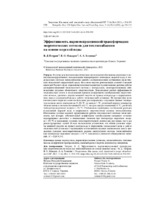| dc.contributor.author | Петраш, В. Д. | |
| dc.contributor.author | Макаров, В. О. | |
| dc.contributor.author | Хоменко, А. А. | |
| dc.coverage.spatial | Минск | ru |
| dc.date.accessioned | 2021-12-14T07:39:53Z | |
| dc.date.available | 2021-12-14T07:39:53Z | |
| dc.date.issued | 2021 | |
| dc.identifier.citation | Петраш, В. Д. Эффективность парокомпрессионной трансформации энергетических потоков для теплоснабжения на основе морской воды = The Efficiency of Vapor Compression Transformation of Energy Flows for Heat Supply Based on the Sea Water / В. Д. Петраш, В. О. Макаров, А. А. Хоменко // Энергетика. Известия высших учебных заведений и энергетических объединений СНГ. – 2021. – № 6. – С. 538-553. | ru |
| dc.identifier.uri | https://rep.bntu.by/handle/data/108172 | |
| dc.description.abstract | В статье результатами аналитического исследования обоснованы режимные условия высокоэффективного использования температурного потенциала морской воды в теплонасосных системах теплоснабжения зданий с соответствующим улучшением экологических показателей окружающей среды. На основе анализа региональных условий Одесской акватории Черного моря определены исходные параметры и рациональные режимы работы усовершенствованной теплонасосной системы с центральным, децентрализованным либо локальным догревом абонентского энергоносителя. Показателями оценки эффективности теплонасосных систем в исследовании приняты коэффициент преобразования энергетических потоков, удельные затраты внешней энергии на привод компрессора и циркуляционного насоса охлаждаемой воды в работе теплонасосной установки. На протяжении всего отопительного периода в качестве исходных рассматривались следующие данные: температура воды на входе в испаритель (5–10) °С, на выходе 1 °С; расчетный перепад температур теплоносителя в системе отопления (50–40) °С, воздуха внутри помещения 20 °С; расчетная температура наружного воздуха (–18) °С. Учитывалось характерное соотношение расходов охлаждаемой морской воды и нагреваемого энергоносителя системы теплоснабжения. Обоснованы условия высокой эффективности работы теплонасосной системы теплоснабжения, при которых действительный коэффициент преобразования превышает сезонное нормированное расчетное и минимальное значения при температуре наружного воздуха (–10) °С в предельных условиях моноэнергетического режима как для новых, так и для реконструируемых зданий. В ходе исследования установлено, что общие удельные затраты внешней энергии на привод компрессора и циркуляцию охлаждаемой воды в работе теплонасосной установки с характерным соотношением водяных эквивалентов даже в предельных условиях моноэнергетического режима эксплуатации системы теплоснабжения при температуре наружного воздуха (–10) °С находятся в диапазоне общепринятых значений (w = 0,28–0,34). | ru |
| dc.language.iso | ru | ru |
| dc.publisher | БНТУ | ru |
| dc.title | Эффективность парокомпрессионной трансформации энергетических потоков для теплоснабжения на основе морской воды | ru |
| dc.title.alternative | The Efficiency of Vapor Compression Transformation of Energy Flows for Heat Supply Based on the Sea Water | ru |
| dc.type | Article | ru |
| dc.identifier.doi | 10.21122/1029-7448-2021-64-6-538-553 | |
| local.description.annotation | The results of the analytical study substantiated the operating conditions for the highly efficient use of the temperature potential of seawater in heat pump heating systems (HPHS) for buildings a building with correspondingly improved environmental indicators. Based on the analysis of the regional conditions of the Odessa water area of the Black Sea, the initial parameters have been substantiated and rational modes of operation of an improved HPHS with central, decentralized or local heating of the subscriber energy carrier have been determined. As indicators for evaluating the efficiency of the HPHS operation, the conversion factor of energy flows and the specific consumption of external energy for the drive of the compressor and the circulating pump of cooled water in the operation of heat pump units were considered. For seawater in the Odessa water area of the Black Sea during the entire heating period, the following temperatures were considered as initial data for analysis: water at the inlet to the evaporator (5–10) ° C, at the outlet (1 °C); calculated temperature difference of the coolant in the heating system (50–40) °C, indoor air (20 °C); estimated outdoor temperature (–18 °C). The characteristic correspondence between the flow rates of the cooled sea water and the heated energy carrier of the heat supply system was taken into account. The prerequisites of high efficiency of the heat pump heat supply system in which the actual conversion coefficient exceeds the seasonal normalized calculated and minimum value at an outdoor temperature of (–10) °C under the limiting conditions of the monoenergy regime for both new and reconstructed buildings were substantiated. In the course of the study, it has been determined that the total specific consumption of external energy for the compressor drive and the circulation of cooled water in the operation of a heat pump unit with a characteristic ratio of water equivalents, even under the limiting conditions of the monoenergetic mode of operation of the heat supply system at an outdoor temperature of (–10) °C, are within the range of generally accepted values (w = 0.28–0.34). | ru |

